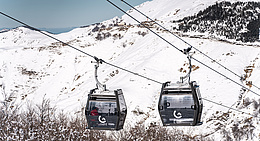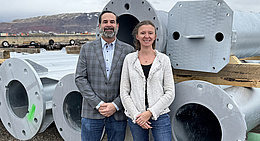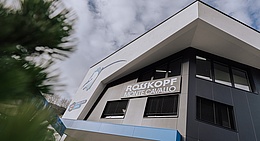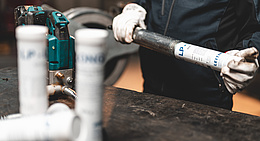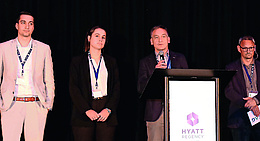During a visit to Paris in 1889, members of the Club of Czech Tourists were inspired by the Eiffel Tower to construct a smaller version in Prague, and the Petřín Lookout Tower Cooperative was founded for the purpose. The result was a 62-meter-high riveted truss structure that was erected on Petřín hill to mark the General Land Centennial Exhibition held in 1891.
In order to provide convenient visitor access to the attraction, a funicular leading from the Malá Strana district to the top of Petřín hill was built by the Petřín Lookout Tower Cooperative and opened in time for the centenary exhibition on July 25, 1891.
First ever water-powered funicular
Prague’s Petřín Funicular and the city’s similarly designed Letná funicular were both built in 1891 as water balance systems. Like most funiculars of the first generation before the invention of the Abt switch, these two Prague funiculars ran on a three-rail track – with the middle rail used by both cars – except for a simple symmetrical passing loop with four rails in the middle of the 396.5 m track. The gage on the Petřín Funicular was 1,000 mm. To control travel speed, with a permissible maximum of 2.0 m/s, a rack with two rows of teeth based on the Abt system was located in the middle of the track. This was an unusual solution, because most funiculars of this type used a Riggenbach rack rail for braking.
The two two-axle cars with a capacity of 46 to 50 passengers each were supplied by the Ringhoffer railroad car manufacturing company of Prague-Smíchov. They were designed with a wooden body with windows along the sides, four staggered passenger compartments and a narrow open platform at either end for the driver, who also acted as brakeman. During the ride, water was continuously released from the descending car to compensate for the increasing length and hence weight of the rope. Operation of the funicular was often interrupted due to the inadequate water supply in the top station. This first Petřín Funicular remained in service until 1914, when it closed, although a number of unsuccessful attempts were made to reopen it.
The second Petřín Funicular
An All-Sokol Slet – a highlight of the physical education activities of the Sokol (Falcon) organization – is a show of mass gymnastics performances for the general public. In 1932, the 9th edition of this gymnastics meeting was to be held in the new Strahov Stadium near Petřín, and the idea of rebuilding the Petřín Funicular was revived, with the project managed by the Electrical Enterprises of the Capital City of Prague (public transport and electric power utilities). The tender was won by the Českomoravská Kolben-Daněk (ČKD) company with its project partner, the German Pohlig company.
The line of the funicular was retained almost unchanged, but the track was extended at both ends for a total length of 510 m. This made it necessary to excavate a cutting for the line to pass under the Hunger Wall, which dates back to the 14th century, and the new top station was built above the wall. The new bottom station was integrated into a building dating back to the Baroque period. The second funicular, with its 1,435 mm standard gage track, had two rails and an Abt switch in the middle of the line. A midline station serving the Nebozízek Restaurant was built above the passing loop.
The new funicular was the first in the world to be equipped with the Pohlig brake cable system. The brake cable – with a separate cable for each car – remains stationary during normal operation; it rests on small rollers near the center of the track along the full length of the line, and runs over small sheaves located in the chassis of the car and through a grip that is open in the normal case. In the top station, both brake cables are wound on drums equipped with powerful brakes; in the bottom station, the brake cables are tensioned with counterweights. Only if the haul rope breaks or detaches from the car, and also if the maximum permissible speed is exceeded by 20%, is the brake cable grip in the car activated, with braking force transmitted via the cable to the brake drums in the top station. In the event of an emergency stop, this elaborate solution was designed to provide smoother braking compared with the conventional solution with emergency brakes acting on one of the rails*).
The cars for the new funicular, this time with a capacity of 100 passengers each, were also built by the Ringhoffer company. At a travel speed of 4.0 m/s, the funicular was able to carry up to 1,300 pph to the top of Petřín hill. Five catenaries were installed above the track, which served for signal transmission, lighting and heating via pantographs on the roofs of the cars.
Work on the reconstruction project made rapid progress; dismantling of the old system began in November 1931 and the new funicular was officially opened on June 5, 1932. It soon became a popular attraction in Prague and was in almost continuous service even during the 2nd World War, except for a few interruptions lasting a couple of months. In 1962 the funicular carried its 15 millionth passenger.
More problems with water
Water again caused problems for this second funicular, although this time there was too much rather than too little water. In June 1961, damage was detected to the retaining walls and the trackbed caused by the seepage of groundwater. Temporary repairs were carried out on the retaining wall and measures for continuous monitoring of the trackbed were initiated as no construction company had free capacity for the work needed for permanent stabilization at the time.
On June 7, 1965, after a long period of rain, a major landslip caused serious damage to the trackbed, thus preventing further operation of the funicular. Although refurbishment of the funicular was unrealistic, in particular following a second big landslip in 1967, former employees of the operating company worked as volunteers to conserve the drive and the car floor frames plus wheelsets and safety brakes in the hope that they could be reused at a later date.
Petřín Funicular Mark 3
It took a full 16 years for the Prague metropolitan authority to make a final decision on the reconstruction of the funicular and, above all, on the rehabilitation of the slope itself. Thanks to the installation of a new drainage system, the slope was stabilized to such an extent that reconstruction of the funicular was feasible. Work started in January 1983 with the construction of a bridge structure founded on deep micropiles in the landslide area in the middle of the line and the refurbishment of the Nebozízek midline station. A new trackbed and track with rope sheaves were laid over the full length of the line, and the drive and brake cable system were re-installed. At the same time the station buildings, which had deteriorated in the meantime, were also refurbished, with the top station reconstructed around the preserved motor room. The Tatra Studénka company fitted new car bodies in a modern design to the preserved undercarriages with the Pohlig emergency cable brakes. Power for the lighting and heating is supplied to the cars while standing in the stations via fixed contacts and current collectors mounted on the car roofs. The new funicular has the same basic operating parameters as the 1932 system. On June 15, 1985, the Petřín Funicular reopened after a 20-year break.
In 1996 the funicular’s electrical equipment and control system were modernized. The drive was equipped with a frequency converter; the Ward-Leonard group was retained as a backup power source. A telemetric link was established between the cars and the motor room, although the funicular still operates with car attendants, who can override the programmed controls if necessary.
After the turn of the millennium, renovation work again had to be carried out several times on the retaining walls and the trackbed. Between autumn 2015 and spring 2016, the funicular again had to be shut down for reconstruction of the bridge near the midline station. At the end of 2018 a new control system was installed.
The funicular is operated as part of Prague’s public transport network. Day tickets and passes issued by the Prague Public Transport company are also valid on the Petřín Funicular. A single ticket to ride the funicular costs 60 crowns (about 2.5 euros).
The Prague metropolitan authority is now planning to replace the funicular with a new system. A design competition for the new cars has already been held; they will have glass roofs for enjoyment of the Prague panorama with St. Vitus Cathedral and nearby Hradcany Castle. In addition to a general refurbishment of the trackbed, all ropeway system components will also be replaced. The new ropeway will be equipped with a standard safety brake acting on one of the rails.
Roman Gric / JN
*) We are not aware of any other funicular in public service that employs this brake cable system. In the USA there used to be funiculars with two haul ropes and a brake cable running round a deflection sheave in the top station.
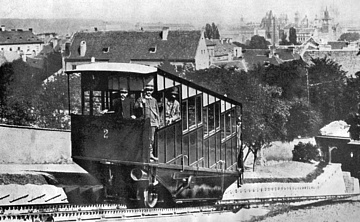
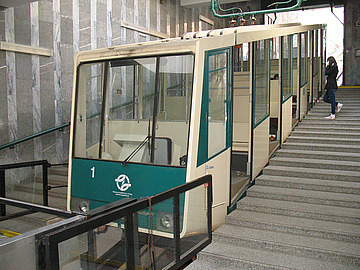

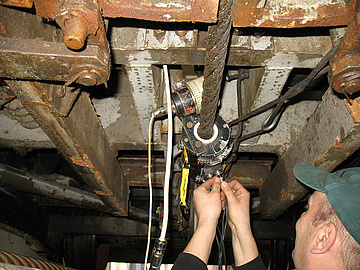

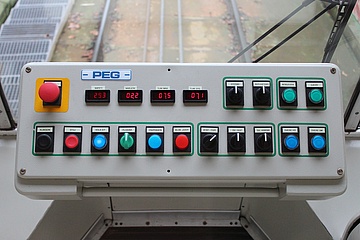
![[Translate to English:] Foto: Leitner](/fileadmin/_processed_/a/8/csm_Vertragsunterzeichnung_Narvik_6_copyright_LEITNER_print_501f2d5c24.jpg)
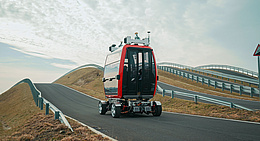
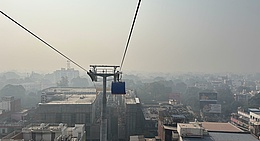
![[Translate to English:] (c) Doppelmayr](/fileadmin/_processed_/b/3/csm_85-ATW_Stechelberg-Muerren_Lauterbrunnen_CHE_001_6442c0520d.jpg)

